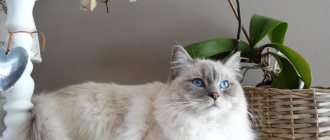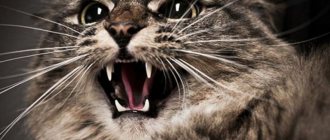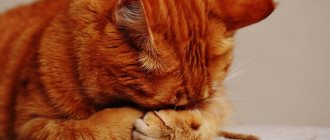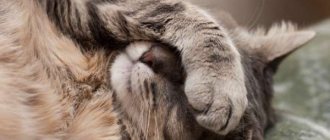If a cat eats flowers in flowerpots, then you need to wean her from this habit. Most indoor plants are dangerous to the health of a pet, as they contain toxic substances that cause gastrointestinal problems, burns, seizures, nervous system disorders, and some can even lead to the death of a pet. The cat may not touch the indoor flowers; he simply climbs into the flowerpots because he is attracted to the soil that the pet digs up. There are ways to help stop your cat from eating flowers and harming them.
According to animal psychologists, consistency, perseverance, and attentive attitude of the owner towards the animal will help protect plants in pots from the encroachments of a furry pet.
Reasons for behavior
There are many reasons for a cat's greed for flowers: from psychological to hidden physiological. Many owners do not take into account that domestic cats inherited the need to eat vegetation as an inheritance from their wild relatives. The herbs stimulated the gastrointestinal tract of forest cats and made it possible to cope with the digestion of meat.
Wild cats always have access to fresh, juicy grass
Since pets cannot enjoy wild plants at home, they have to be content with equivalents. Even inedible aloe or cacti can be used, as if they hypnotize animals.
Table 1. Reasons why cats eat flowers
| Cause | Details |
| Play behavior | Plants, and flowers in particular, often attract cats due to both their bright colors and strong scent. Cats have a well-developed sense of smell and react to objects with a rich odor. First, the pet touches the leaves with its paw, then carefully tries it with its tooth. Having gotten used to the new “toy” and realizing that it is safe, the cat begins to take active action and gives itself free rein. |
| Hunting for flora | Despite the fact that flowers bear little resemblance to rodents or birds, they can awaken the hunting instincts in a cat. While fighting with prey, the pet may forget itself and even knock over a vase or pot with filler on the floor. A torn plant with tattered leaves is defeated, and the cat is in a state of shock |
| Indigestion | Even the healthiest pets feel the need to help their own intestines, whose peristalsis is often slow. Plants speed up the process of digesting food and relieve cats from unpleasant constipation, as well as life-threatening intestinal obstruction. Most often, cats that eat dry food and need gastrointestinal support pay close attention to plants. |
| Avitaminosis | Lack of vitamins in the bodies of pets is not uncommon in urban environments. Living within four walls, they practically never get access to fresh air or open sun. The situation can also be complicated by an unbalanced diet, which does not allow the cat to replenish its supply of nutrients. As a result, the pet begins to look for other ways to get enough vitamins, which sometimes surprise owners with their unusual nature. |
| Parasitic infestations | Due to the already indicated property of vegetation to cleanse the intestines, cats turn to flowers when they want to rid their gastrointestinal tract of parasites. Plants irritate the intestinal mucosa and allow animals to achieve the long-awaited urge to vomit. If you see that interest in flowers is combined with a sharp weight loss and general malaise, then it would be a good idea to take your pet to the veterinarian to prescribe medications. |
| Mental pathologies | This group of reasons is quite wide and may include problems of various origins. Mental pathologies can occur due to traumatic brain injury, electric shock, or be the consequences of unsuccessful drug treatment. One way or another, the pet loses the line between edible and inedible and begins to eat everything it sees. This situation is dangerous due to intestinal blockage or serious poisoning and requires long-term treatment |
| Obsessive states and obsessions | Not only people, but also animals are prone to compulsive actions. This disorder is a consequence of intense emotional experiences, colored in anxious or even panic tones. Eating flowers helps the cat temporarily relieve stress through active jaw movements. This disease is most common among oriental breeds and, in general, is quite rare with normal handling of the pet. |
In addition to eating flowers, pets may also become interested in the soil from which the flowers grow. Some cats try to use potties as an alternative to the litter box. Since in natural conditions wild cats use the soil to bury excrement, this type of “filler” is always a priority for domestic predators.
Earth is the most natural “litter box filler” recognized by all cats.
If you have been struggling with this behavior for a long time, then it makes sense to think about changing the litter for the tray. Probably, the cat does not have enough natural materials in which he could calmly relieve himself. Sawdust or clay can be a worthy substitute for soil in pots and distract your pet from the flowers. You can read in more detail about the types of fillers for trays and their features on our portal.
How to stop a cat from spoiling flowers
Once the reason for the cat’s addiction to the garden on the windowsill has been established, it should be eliminated.
Replace with more attractive ones
If the diet does not have enough nutrients, then you need to try another food that contains plant components.
You can offer your pet a “vegetable garden.” The pet store sells special sets of cereal seeds (rye, wheat, barley), sprouts that cats love.
The animal will like this replacement more. You can grow plants in pots that are not only safe, but also a desirable treat. You should plant for your pet:
- mint;
- lemon balm;
- catnip (catnip);
- thyme;
- thyme;
- primrose (evening primrose);
- Matricaria (feverfew).
They smell nice, look beautiful and purrs like them.
Scare away
Smells that your cat cannot tolerate will help keep you away from potties. You can add a few drops of citrus essential oil (orange, lemon, grapefruit) to a spray bottle or spread the peels of these fruits around the pots. But it will have to be changed to a fresh one every 3 days. Experienced owners give advice on how to scare a cat away from flower pots - “shoot” at it with a water pistol as soon as the mustachioed robber starts chewing the leaves of his favorite geranium. But this technique can do more harm than good:
- The owner will have to be on duty around the clock next to the flowers, keeping watch for the prankster.
- If the cat is “stressed” by flowers, then an unexpected shower will only aggravate the condition and can lead to psychogenic diseases or a nervous breakdown.
- Cats already do not like water procedures, and a well-aimed “shot” can create problems with bathing the animal for a long time.
Specialized means.
There are special sprays for repelling - “Anti-gnat for cats”, Goodbye cat repellent spray, AnimAll (Animal) and other humane means.
They are attracted by the scent of plants
A cat’s sense of smell is very sensitive; it is, of course, not as developed as a dog’s, but much better than human perception. There are plants whose smells not only please cats, but give them pleasure. These are catnip, valerian and the like, containing substances that smell like cat sex hormones to animals.
But among cats there are lovers of other scents; some adore the scents of carnations, pine needles, mimosa, violets and other house flowers.
Unusual entertainment
Like people, our pets can not only be sad and happy, but, for example, also be bored. And boredom causes the most seemingly absurd situations to happen. A bored cat may become interested in a potted flower out of curiosity. He sniffs, touches with his paw, bites the moving leaves and flowers, if he really likes it, he can dig up the ground, and “accidentally” drop the pot on the floor - everything is more fun than just lying on the bed.
You can also tease your owners out of boredom. Many cat owners know firsthand that their pets deliberately do what they are often scolded for: sharpening their claws on furniture, throwing objects off the table, picking at the soil in a flower pot. And how interesting it is for them to then run away from an angry owner and hide under the sofa or behind a closet. What don't you do when there is nothing else to do?
Why you need to stop your cat from eating indoor flowers
For people who have little knowledge of indoor floriculture, the question of why it is necessary to wean a cat from eating flowers is perplexing. Wean? For what? Let him gnaw, what's wrong with that?
In fact, weaning a cat from eating indoor flowers is the number one task for a caring and responsible owner. Most of the plants that decorate our windowsills are poisonous to one degree or another - and not just to cats. Even such familiar plants as asparagus, spathiphyllum, callas, all types of ficus and pelargonium, not to mention amaryllis, hippeastrum and ivy, pose a great danger, careless handling of which can lead to severe poisoning not only of the cat, but also of the owner himself. . The beauty and pride of our gardens and loggias - hydrangeas - can provoke an attack of acute intestinal upset, abdominal pain, nausea and vomiting. A wonderful garden and balcony plant - hellebore - leads to heart rhythm disturbances. Even everyone’s favorite bulbs (tulips, daffodils, hyacinths, muscari), which we put out for forcing for the New Year and spring holidays, should be kept as far as possible from our pets: their pollen can cause an allergic reaction in them.
Many exotic plants that can be found in our homes are deadly to cats. The substances they contain can cause severe intoxication, depression of the respiratory center, heart and blood vessels, muscle spasms, paralysis and anaphylactic shock. The juice of many varieties of ficus leads to burns of the mucous membranes (as a result of this, not only the animal’s oral cavity suffers, but also the larynx, esophagus, stomach), and affects the liver and kidneys.
No less dangerous than the plants themselves are flower care products. Treatment of plants with acaricidal preparations and foliar feeding should be carried out out of the reach of pets.
Young kittens need to be monitored especially closely. Trying to taste a poisonous plant can end very badly.
If you keep a cat and at the same time plan to take up indoor or garden floriculture, be sure to ask an experienced veterinarian which plants are safe for your pet and which ones should be discarded immediately.
What to do if your cat ate a poisonous plant?
Symptoms of poisoning by harmful indoor plants: the cat is vomiting, diarrhea, the mucous membrane of the mouth is inflamed. If you suspect that the cat was poisoned by an indoor flower, then take the plant itself or at least part of its leaf or stem to the veterinarian.
If you can’t immediately get an appointment with a veterinarian, start acting on your own.
First, you need to induce vomiting in the cat. To do this, soapy water with the addition of hydrogen peroxide or warm salt water is injected into the animal's mouth. If it was not possible to give the cat these solutions to drink, you will have to do an enema.
Give the injured animal a special “cocktail” that slows down the absorption of poison into the blood: mix milk, eggs and sunflower oil. If the cat does not want to drink on his own, pour the mixture into his mouth. Still, it is better to call a veterinarian at home.
We wish your home peaceful coexistence between all household members!











